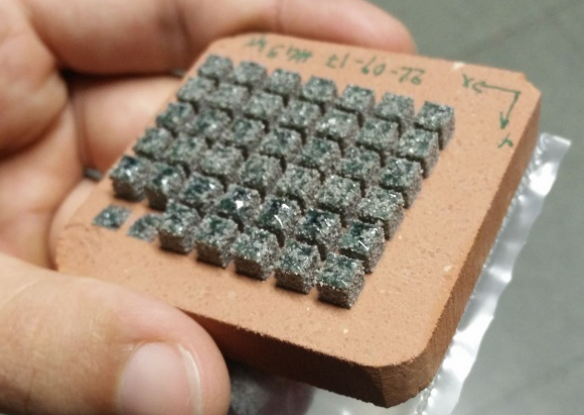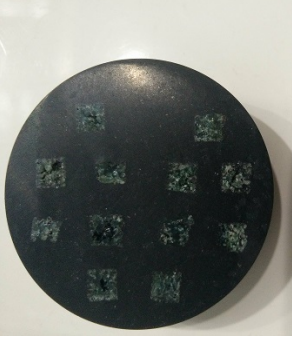Our fascination with space travel is never-ending, and the reality that we have been able to travel to the moon is still a source of keen fascination (or perhaps question, if you are a conspiracy theorist on the subject!). Colonization in space is a key factor in many sci-fi movies today, as well as the topic of numerous conferences held around the world in recent years—with housing in space being one of the main hurdles. With the advent of 3D printing (not to mention its many uses by NASA over the decades), colonization seems more viable due to the potential for taking simple machinery that could make use of ‘local’ materials—whether on the moon or a faraway planet like Mars.
So far, it is expected that regolith (known more whimsically as ‘moon dust’) will play a starring role in housing materials for those lucky space inhabitants of the future—and researchers around the world have been toying with exactly how that could work. Now, Italian researchers Lorenzo Abbondanti Sitta and Michele Lavagna of Politecnico di Milano, Italy have published ‘3D Printing of Moon Highlands Regolith Simulant,’ discussing the potential for 3D printing a simulated regolith for use in fabricating small structures and objects.
3D printing in space offers most of same benefits embraced here on Planet Earth—speed and efficiency in creation, as well as ease in making changes to designs. Affordability is often key, along with the ability to cut out the middleman in production of parts—as well as labor in erecting structures.
“The use of 3D-printed material for building purposes must be supported by experimental evidence of the mechanical properties useful for this objective,” state the researchers in their paper. “In the previous works the majority of the tests were conducted on the material density and the surface hardness without considering the interest arising from the knowledge of other mechanical properties such as the compressive strength. In this work surface hardness and overall quality of the products are studied to offer a comparison with the previous results, but the study is completed by investigating the effective material resistance to compressive loads.”
The authors examined preparation of materials, the printing process, and results, which showed definite feasibility amidst some challenges. The main material in use for the project was known as test material NU-LHT-2M, a raw regolith simulant powder conducive to selective laser melting (SLM) 3D printing.
The presence of moisture was one issue:
“To avoid as much as possible the contamination due to water presence, the solution was to put the batch in a thermovacuum chamber for 24 hours after which it was kept in silica sealed containers. Water presence proved afterwards hard to completely avoid but the experiments were not compromised by the small residues left in the powder used.”
Size of the granules was challenging as well, but not insurmountable:
“Aside from the results, some larger grains were later found making mandatory a quick preprocessing before loading the machine, comprising hand sieving and visual inspection of the material used,” stated the researchers.
“The inclusion of an automated sieving process may improve the quality of the powder and lead to increased precision and repeatability of the printing, but in this work one of the goals was to determine how much adverse condition, also in terms of material quality, could impact on the feasibility of the process, thus the sieving was performed only when the size of the grains were such to completely prevent the machine from operating correctly.”
3D printing of the regolith simulant was scrutinized regarding:
- Power
- Speed in scanning
- Hatching space
- Layer thicknesses
- Focal point offset
Initially, there were challenges with adhesion. The researchers did, however, find better success with a ceramic substrate.
“The substrate chosen for the test is a refractory clay commonly used for high temperature oven or kiln, thus capable to withstand the large amount of thermal energy exchanged during the process and, at the same time, having a chemical composition closer to that of the powder used. The possibility of coating the metal substrate with a thin layer of the NU-LHT-2M was discarded due to higher costs and difficulties of implementation in the process.”
In conclusion, the researchers found this project to be a good starting point. To understand what is fully needed for colonizing and building in space, however, they will need to research more regarding materials and 3D printing processes.
“Next steps in this work will comprise thermal analyses and radiation shielding properties investigation on printed objects, together with an increase in the TRL of the machine used which could be scaled and adapted to be space certified and approved for a flight demonstration or even an IOD mission,” stated the research team.
What do you think of this news? Let us know your thoughts! Join the discussion of this and other 3D printing topics at 3DPrintBoard.com.
[Source / Images: ‘3D Printing of Moon Highlands Regolith Simulant’]Subscribe to Our Email Newsletter
Stay up-to-date on all the latest news from the 3D printing industry and receive information and offers from third party vendors.
You May Also Like
Gorilla Sports GE’s First 3D Printed Titanium Cast
How do you help a gorilla with a broken arm? Sounds like the start of a bad joke a zookeeper might tell, but it’s an actual dilemma recently faced by...
Nylon 3D Printed Parts Made More Functional with Coatings & Colors
Parts 3D printed from polyamide (PA, Nylon) 12 using powder bed fusion (PBF) are a mainstay in the additive manufacturing (AM) industry. While post-finishing processes have improved the porosity of...
$25M to Back Sintavia’s Largest Expansion of Metal 3D Printing Capacity Since 2019
Sintavia, the digital manufacturing company specializing in mission-critical parts for strategic sectors, announced a $25 million investment to increase its production capacity, the largest expansion to its operations since 2019....
Velo3D Initiates Public Offering in a Bid to Strengthen Financial Foundations and Drive Future Growth
Velo3D (NYSE: VLD) has been among a number of publicly traded 3D printing firms that have attempted to weather the current macroeconomic climate. After posting a challenging financial report for 2023,...

































